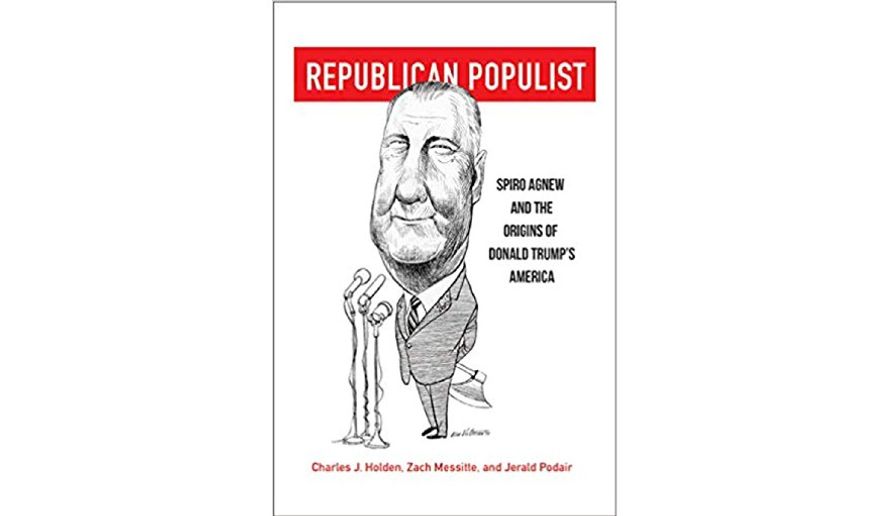OPINION:
It’s the contention of Charles J. Holden, Zach Messitte and Jerald Podair that “Richard Nixon’s selection of Spiro Agnew to be his running mate in August 1968 proved to be one of the most underrated, consequential decisions in modern American politics, and it still reverberates a half century later.”
They make their case in strong, lucid prose that might be unexpected in a troika of academics writing about Spiro Agnew, to say nothing of Donald Trump — no trace, in other words, of nattering nabobs of negativism — just a thoughtful, deeply researched and considered analysis of the evolution of the modern Republican Party, and the central role in that transformation played by Vice President Agnew.
The key moment for the party, the administration and for Agnew came when Pat Buchanan sent a memo to President Nixon suggesting that the vice president deliver a speech on the responsibilities of the media at a Midwest Regional Republican meeting in Des Moines, Iowa, on Nov. 13, 1969. Nixon, smarting from the treatment he’d received from the networks for his address to the nation outlining his plans for ending the war in Vietnam that his Democratic predecessors had dropped in his lap, gave the go-ahead.
Mr. Buchanan wrote four drafts, Nixon proofed the final one, Agnew delivered it and the networks covered it. A small group of men, Agnew told the nation, exercised monopoly control over a powerful means of communication and were using that power to advance their shared ideological and political agenda. As the authors point out, the speech “became an instant classic,” which was “met with hue and cry from the very media ‘elite’ Agnew attacked — proving to his followers his point.”
The attacks on the media, combined with a series of highly effective speeches aimed at the social and economic concerns of working- and middle-class Americans, “catapulted Agnew to a new level of national political prominence.” In fact, write the authors, “he was legitimately being touted …. as an early leader for the 1976 Republican presidential nomination.”
But first came !972 and re-election. As the authors point out, impressed with John Connally, Richard Nixon was less than enthusiastic about keeping Agnew on the ticket. But powerful conservative figures like Sen. Barry Goldwater and groups like the American Conservative Union made their opposition to any change in the vice presidency known to the White House, a process facilitated by Agnew’s highly effective and connected political aide, David Keene. And the message was received.
In 1972, Agnew was designated the administration’s chief campaigner (full disclosure: I traveled with him as chief writer), logging some 45,000 air miles and speaking to enthusiastic crowds in 56 cities in 36 states. The result of the election was a historic landslide victory, and a good part of the credit for it could be claimed by Spiro Agnew, who awakened the Silent Majority and gave them voice.
And in the process he also gave himself an unexpected future. One of the slogans increasingly seen at rallies, along with “Say it Again, Spiro,” and “Spiro is our Hero,” was “Spiro of ’76.”
And when the Watergate tom-toms first began to beat, the thought was it might happen even sooner, with the most unlikely people discovering his virtues.
James Reston called him “the personification of the Old American Verities;” there was a sudden wooing by neo-con intellectuals; and as the authors note, “Just ten days before the U.S. attorney’s investigation into Agnew became public, syndicated columnist Stewart Alsop wrote, ‘It again seems possible that Vice President Spiro Agnew may become President before 1976. It is also entirely possible that he may be elected in his own right in 1976.’”
Some believe that the charges against Agnew were trumped up to prevent precisely that from happening. But the accepted judgment is probably rendered by Pat Buchanan: “‘[T]here has never been a Vice President like him, who came to national politics an unknown, ascended to the heights in the esteem and affection of half his countrymen, then fell so low and hard …. Had he left the practices of Annapolis back in Annapolis, Spiro Agnew would have been President.’”
But with “the emergence of Ronald Reagan as the voice of the silent majority,” the reinvention of the Republican Party in the 1980s, and Donald Trump attempting to follow the blueprint, Spiro Agnew, conclude the authors, “is one of the rare public officials, in his or any other American era, who can lay claim to a legacy.”
• John R. Coyne Jr., a former White House speechwriter, is co-author of “Strictly Right: William F. Buckley Jr. and the American Conservative Movement” (Wiley).
• • •
REPUBLICAN POPULIST: SPIRO AGNEW AND THE ORIGINS OF DONALD TRUMP’S AMERICA
By Charles J. Holden, Zach Messitte, and Jerald Podair
University of Virginia Press, $29.50, 259 pages




Please read our comment policy before commenting.